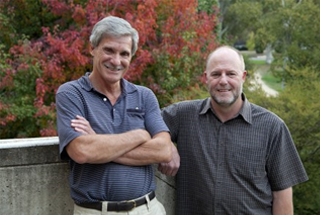The power of nature

Two and a half billion years of chemical experimentation through evolution may be about to provide us with a remarkable solution to the global energy crisis, writes SOPHIA CALLANDER.
Earth is facing a problem. As our population rises and our impact on the planet grows, we can no longer rely on oil or coal to power our cars, provide our electricity and generate our heating. The search is on for a clean, renewable fuel.
One of our most promising renewable fuel sources is hydrogen, which is completely sustainable and clean because it produces only water vapour when burned. Unfortunately, current methods of generating hydrogen are inefficient and expensive, and its development has fallen behind cheaper options like solar and wind power.
But Professors Robert Stranger and Ron Pace from the ANU Research School of Chemistry have been researching a natural process that could hold the answer to our energy needs.
“We now live in an electric world but we still need storable fuels to do lots of things because batteries are not good at storing energy,” says Pace. That’s something that most people don’t realise.
“Things like gasoline are great for storing energy, but the problem is that when you burn gasoline you generate a lot of carbon dioxide as well. That’s why we’re really interested in hydrogen: when you burn it, you don’t get carbon dioxide – only water vapour and plenty of energy.”
Together with their colleague Simon Petrie, Stranger and Pace have been looking into photosynthesis – the process by which plants convert carbon dioxide and water into oxygen and energy using the power of the sun. It just so happens that a critical step in this reaction involves splitting water to produce hydrogen.
“Nature has developed the most highly efficient engine you could possibly have to split water and produce hydrogen. If we can mimic it, we’ve got a fantastic mechanism to have a renewable energy source,” says Stranger.
The team have discovered not only the molecular structure by which plants split water during photosynthesis but also the mechanism, using computational chemistry.
“Now we know what the molecular structure looks like. Now we know how it produces hydrogen. And through doing so, now we know what important bits of it we need to build a mimic of it. In other words, we know how to create artificial photosynthesis,” says Stranger.
“That’s the key to this – stealing nature’s secret. It’s got the perfect machine, so let’s copy it!”
For those conjuring up images from Day of the Triffids, the reality of this power plant is something quite different.
“The idea is not that you produce a sort of giant mechanical plant. A functioning artificial photosynthesis industrial entity might look in many parts like a wind farm or a voltaic field and uses the cheapest available source of water – seawater – to generate hydrogen,” says Pace.
“We can build factories, we can run pipelines and powerlines, which means that we can combine the secrets that we learn from nature with our own strengths, to produce an outcome that is better than either.”
Not only does photosynthesis provide the oxygen we breathe and the food we eat, it may also hold the key to sustaining the energy needs of our future.
Video: Learn more about artificial photosynthesis http://bit.ly/rep_artphot
This story appeared in ANU Reporter magazine. Read the full issue at http://news.anu.edu.au/publications/anu-reporter/
